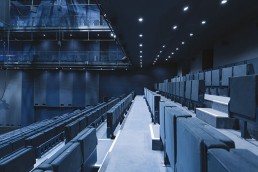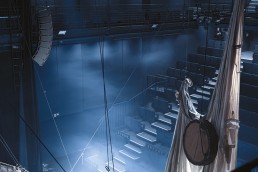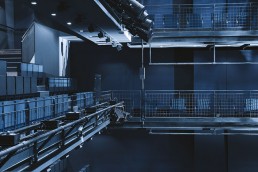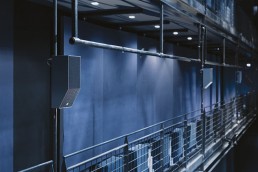This website uses cookies so that we can provide you with the best user experience possible. Cookie information is stored in your browser and performs functions such as recognising you when you return to our website and helping our team to understand which sections of the website you find most interesting and useful.
La Scala
ProjectLa ScalaLocationParis, FranceManufacturers Amadeus, PowersoftInstallerCETA, BL&FSubmitted by Amadeus
Originally built in 1873, La Scala Paris is now an art house theatre after a complete renovation and remodel, which began in the spring of 2016 before being completed two years later in 2018. During the renovation and design stage, the theatre had constructive dialogue with many of today’s top artists in every discipline in a bid to help create the ideal platform for their creative productions.
The venue has scalable tiers, created by scenographer Richard Peduzzi and built by the CETA (Bergamo) and BL&F (Padova) companies. The theatre’s mobile tiers can be split, and are controlled electronically with a joystick; they enable several setups, to better serve any form of scenic creation and artwork – frontal, bi-frontal, tri-frontal and quad-frontal. These audience tiers are complemented with seating in two balconies and side passageways, hosting around 100-seats in each of the two levels.
In the frontal version setup, the large hall has a capacity of 560-seats, expandable to accommodate up to 750 people. This exceptional modularity of the theater space – which takes less than 45 minutes to modify its configuration – led to the design of a technical platform adapted to the hall dimensions. The platform allows for the deployment of any rigging system for audio, lighting, and video, regardless of the demands presented by stage directors, choreographers, conductors, video makers and artists.
Thanks to its modularity and its variable acoustics, La Scala Paris offers creation, production and performance conditions second to none in the French capital.
For the audio system at La Scala Paris, Amadeus installed over 170 of its loudspeakers, as well as its HOLOPHONIX immersive audio processor. Throughout the renovation process, Amadeus was deeply involved, allowing it to design a sound reinforcement system that would allow productions a boundless array of audio control and choices – all with the very highest, audiophile-level sound quality. The electro-acoustic sound reinforcement system was designed specifically for La Scala Paris by Amadeus – in collaboration with composer, Philippe Manoury and scenographers, Patrice Buniazet and Richard Peduzzi. The result is an outstanding sound system with modularity that enables an almost limitless number of configurations and possibilities for all types of performers and theatrical presentations.
The audio setup is built around HOLOPHONIX spatial sound processor, designed by Amadeus in collaboration with STMS Lab (Sciences et Technologies de la Musique et du Son), located in Paris, and supported by CNRS (National Center for Scientific Research), Sorbonne University, French Ministry of Culture, and IRCAM (Institut de Recherche et de Coordination Acoustique/Musique).
The HOLOPHONIX processor creates an extremely advanced platform, which is able to mix, reverberate and spatialise sound content played from various devices using several different spatialisation techniques in two or three dimensions. It allows users to select and combine these techniques – or algorithms – in real time.
The sound and acoustics-related choices were made by La Scala’s owners, Mélanie and Frédéric Biessy, after they had met with artists, such as Philippe Manoury, Philippe Hersant, and Philippe Schoeller.
“We wanted to build a system that would be able to adapt to any live show and any concert – even the most acoustically and sonically challenging,” explained Mélanie. “Our meetings and exchanges with IRCAM were also a key factor in transforming La Scala into a facility with unique acoustical specifications. The hall’s acoustics and sound reinforcement system are at the core of our project, and it makes La Scala even more than a concert hall,” she continued.
Spread around in a hemisphere shape, enveloping the viewers and adapting to the geometrically shaped building – all while controlling the technical and aesthetical constraints in the Grande Salle, the new sound reinforcement system at La Scala Paris uses 172 loudspeakers, all designed and built by Amadeus at its Paris headquarters.
Some loudspeakers – especially those fixed on the two upper catwalks – were designed specifically by Amadeus for the La Scala. The loudspeakers installed on the first catwalk are set at a 6.5-metre height from ground with the front panel slanted, while the coaxial transducer is aimed naturally at a 30º angle to get an optimal overlap in the listening area. On the second catwalk, the front panel of the loudspeakers are tilted at 45º. Three loudspeaker ‘antenna’ systems are fixed under every balcony as delayed systems. Each ‘antenna system’ is made of 12 Amadeus PMX 4 coaxial loudspeakers, evenly distributed over the whole width, with an inter-source distance of 1.25-metres. A frontal high power line array system is also part of the global system. It is made of 18 DIVA M² loudspeakers – a new model in the Amadeus product range. Several audio configurations are used at La Scala; the main L-R is made of nine DIVA M² loudspeakers in each array, the L-C-R is six DIVA M² loudspeakers per array, with the multi-diffusion setup also consisting of six DIVA M² loudspeakers.
The HOLOPHONIX poly-algorithmic processor offers a quasi-unlimited number of buses – or spatialisers – and each one can run an embedded spatialisation algorithm, including Higher-Order Ambisonics (2D, 3D) Vector-Base Intensity Panning (2D, 3D), Vector-Base Amplitude Panning (2D, 3D), Wave Field Synthesis, Angular 2D, k-Nearest Neighbor, Stereo Panning, Stereo AB, Stereo XY, Native A-Format Ambisonics, Native-B Format Ambisonics, and Binaural. In the Grande Salle, three Wave Field Synthesis (WFS) spatialisers are used to precisely drive each delayed loudspeaker ‘antenna’ system under the balcony, according to differentiated spatial positions. A Higher-Order Ambisonics 3D bus drives the loudspeakers installed as a ring around the audience, on the first and second level catwalks, and on the ceiling. A Vector-Base Amplitude Panning (2D) bus drives the loudspeakers placed at the balcony level, behind the audience.
Depending on the project being presented at the theatre, the loudspeakers can be discretely added. They are managed by an Angular 2D or k-Nearest Neighbor spatialiser, or directly routed to a physical source through the HOLOPHONIX processor system.
The complete audio system is amplified and processed by DSP amplifiers from Powersoft. They handle all fundamental system parameters; EQ, time alignment between different sections, limiters, fine-tuning, and speaker thermal protection.
“Technologies linked to immersive and spatialised sound are now coming out of laboratories to enter entertainment venues. They embody a new audio revolution, as an integral component of avant-garde visions in many French institutions such as La Scala Paris, le Théâtre National de Chaillot, le Théâtre du Vieux-Colombier, Les Champs Libres, and others. All these performance spaces were among the first to believe and invest in these immersive audio technologies,” concluded Gaetan.





